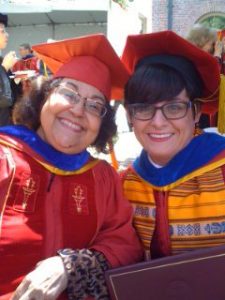These are the Dia de Los Muertos alters created by the students in this class and their reflections on them. Please read through the class alter reflections and leave comments.
Author Archives: Proffers Perez
Migration and Children
This week’s viewing and listening are around the experience of migration and immigration and what the experience of being undocumented does to children. Please respond to these works: “Are the Kids Alright” and “Which Way Home” below. What are the experiences of children from families who are undocumented? What are the effects of this stress? How can or should Chicana/o studies and Chicana feminist theory help us respond to the threats experienced by undocumented children? What should be our response to the threats posed by deportation?
You may also respond to this with your own questions and other readings you find helpful or thought-provoking.
Thanksgiving Traditions
After listening to Latino USA’s podcasts I’ve linked to on Blackboard, please write a response in the comments below. How would you answer the podcasts’ questions about Thanksgiving, a Latino spin or no?
I’ll start.
Thanksgiving Day my partner and I spend with friends rather than family because a lot of my family works on Thanksgiving due to the extra overtime they can earn on Thursday. For our friends’ Thanksgiving I make pumpkin pie and cranberry apple pie. Most of the people we celebrate live in Los Angeles now, but are from out of state. On the Friday after Thanksgiving, my mom generally makes the whole turkey dinner with trimmings. The Californianess of it is we spend the time outside. We also usually have tamales as a side dish for Thanksgiving.
Our other holiday tradition is we draw names to know who we’re going to buy Christmas gift for.
Week 7 – Midterm Week
This week you will be taking midterms through Blackboard. The exam is available all week and is due Friday, October 7 at 5pm.
Good luck! There are no reading or blogging assignments for this week.
Dia de Los Muertos Project (Part 1)
For your term project you’re going to make a Día de Los Muertos alter for a member or members of your family as a digital project. You can go about this a number of ways. You can build an actual alter and take pictures and / or video of it. You can create it as a solely digital piece using something like Google slides. Or you can come up with some variation of your own. Your end product needs to be something you can either upload to the class blog or link to from the blog.
Note that there are many variations on how alter can be made and what items it should or can include. It can be alter honoring and remembering one person or one that remembers many. It should include items that are specific to memories of the person or people who the alter is for. Use online sources for alter ideas.
Your alter needs to be constructed (however you describe that) by October 19. It’s going to be the basis for several pieces of writing between then and the end of the semester. Throughout the process, share pictures and thoughts about your alter on Slack.
Alter ideas:
http://www.themijachronicles.com/2011/11/how-to-make-a-dia-de-los-muertos-altar/
http://www.texasmonthly.com/the-culture/how-to-build-a-dia-de-los-muertos-altar
http://www.scpr.org/news/2013/10/30/40094/how-to-build-a-dia-de-los-muertos-altar-photos/
http://www.npr.org/sections/thesalt/2014/10/29/359829045/decoding-the-food-and-drink-on-a-day-of-the-dead-altar
http://archive.azcentral.com/ent/dead/altar/tradaltar.html
Week 4 Assignments
In addition to your usual weekly blogging assignments, you are to do a film review about a film that focuses on Chicana/o family. The assignment is: A 500 word review, focusing on one or more of the issues raised in the course readings so far, of one of the following films:
La Bamba
Quinceañera
Bread and Roses
Real Women Have Curves
You are responsible for finding and viewing the film you choose on your own. You may request to use another film but must do so to Dr. Perez by Wednesday, September 14.
Review is due by Friday, September 15. You must post it to the class blog AND submit it to the TurnItIn link in this week’s Blackboard folder.
Readings:
Rodriguez, Chapter 2
Noriega, “Imagined Borders” from the book The Ethnic Eye. This reading is in place of “This is Not a Border” It is available electronically through the CSUDH library.
Blogging:
Regular blog assignments on readings from Week 3 and Week 4.
Please let me know if there are any questions.
Week 1 Assignment: What is Chicana/o?
Using crowd sourcing, we’re going to develop a working definition of Chicana/o. In the comments below, I want you to write a paragraph (100-200 words) giving something of a definition / impression or sense of what Chicana/o means. Use the ‘net and any other books you may want. Cite your sources by putting in links and MLA citations. Sound fun? Hope so. Here’s the catch. Each webpage can only be cited once. So if someone has already put up a link, you need to find a new one. Look at each other’s links and make comments if the spirit moves you. Make sure you finish putting your links up (you can keep on reading and commenting of course) by 11:59 Pacific Time Friday, August 26.
Example: Actor Cheech Marin starts out his essay titled “What is a Chicano” with the phrase “Who the hell knows?” He then goes on to say to be a Chicano you have to declare yourself a Chicano — which I take to mean that he sees being a Chicano as a choice. He goes on to specifically say: “That makes a Chicano a Mexican-American with a defiant political attitude that centers on his or her right to self-definition. I’m a Chicano because I say I am.” I think he’s right, but I also use “Chicana/o” to refer to Mexican Americans generally. So I’m still left wondering, what is a Chicana/o?
Citation: http://www.huffingtonpost.com/cheech-marin/what-is-a-chicano_b_1472227.html
Marin, Cheech. “What Is a Chicano.” The Blog. The Huffington Post. 2012. Web. 15 Jan. 2014.
Note: your first comment response may take longer to show up as it needs to be hand moderated.
Dr. Perez Bio
My favorite thing to do used to be calligraphy but I don’t do very much of it anymore. Now I love reading and working with all things digital, especially ways that show off my students’ research and writing the way this blog will. I love looking at pictures of pets and very much want a dog of my own. Sadly my landlord says no. Boo.
This picture was taken on one of the happiest days of my life — the day my PhD advisor hooded me, making me a “doctor.”
The thing I most want you to know about this class and why I do what I do:
There are not enough voices engaged in Chicana/o studies in this university, in this state, in this country, in this world. Our artists, our people are under attack and it has pretty much ever been so. Yet there is so much that is significant in Chicana/o thought, in literature, art and in our own lives. I teach what I do the way I do because I want us to see it and talk about it together. I want my classes to add to and be part of this collection, to hear the voices from our past and amplify them. I want your voices to be amplified, your word to be read, your art seen. And so there is a lot of for us to look at, to read, to watch, to uncover. It is work and it is amazing.
Week 1: Welcome and Bio Assignment
Welcome to Chicana / Chicano Studies 486
We’re going to be spending this semester studying, exploring the Chicana / Chicano family and in the process, hopefully learn more about our own families and traditions.
Your first blogging assignment is going to be to write your biography using whatever name you choose to go by for this course. WordPress can be a little tricky to use, so if you haven’t used it before, please follow the instructions. Once you’ve written your post, please go through and read the introductions of your classmates. You should include an image (instructions for adding an image are here).
Bio post needs to be posted by Friday, August 28 at 11:59PM.



